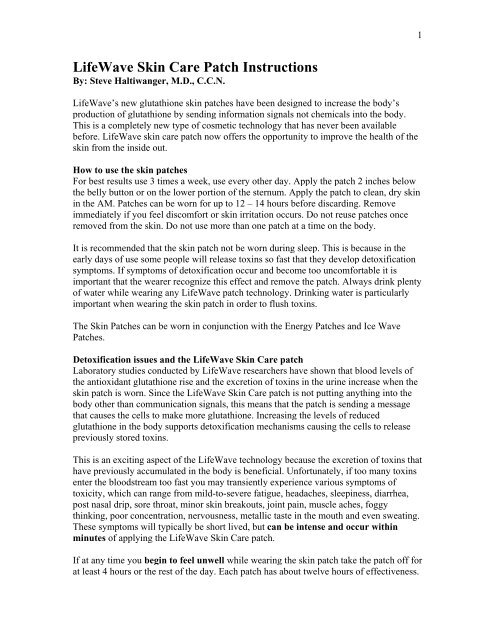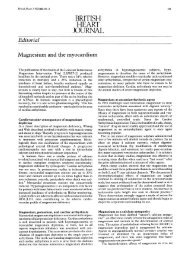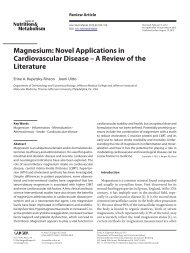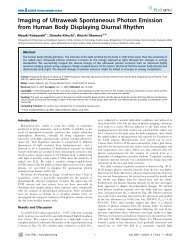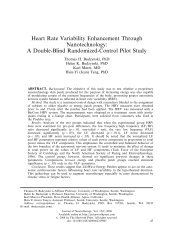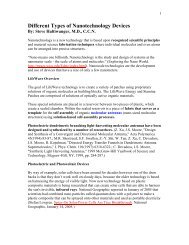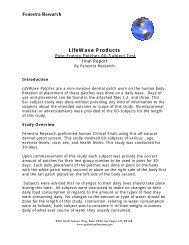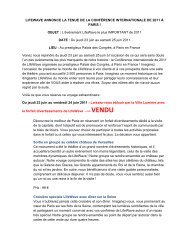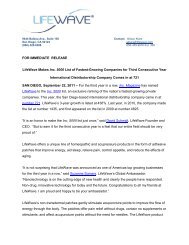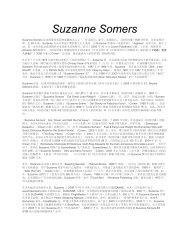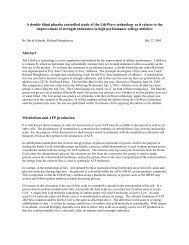LifeWave Skin Care Patch Instructions
LifeWave Skin Care Patch Instructions
LifeWave Skin Care Patch Instructions
Create successful ePaper yourself
Turn your PDF publications into a flip-book with our unique Google optimized e-Paper software.
<strong>LifeWave</strong> <strong>Skin</strong> <strong>Care</strong> <strong>Patch</strong> <strong>Instructions</strong><br />
By: Steve Haltiwanger, M.D., C.C.N.<br />
<strong>LifeWave</strong>’s new glutathione skin patches have been designed to increase the body’s<br />
production of glutathione by sending information signals not chemicals into the body.<br />
This is a completely new type of cosmetic technology that has never been available<br />
before. <strong>LifeWave</strong> skin care patch now offers the opportunity to improve the health of the<br />
skin from the inside out.<br />
How to use the skin patches<br />
For best results use 3 times a week, use every other day. Apply the patch 2 inches below<br />
the belly button or on the lower portion of the sternum. Apply the patch to clean, dry skin<br />
in the AM. <strong>Patch</strong>es can be worn for up to 12 – 14 hours before discarding. Remove<br />
immediately if you feel discomfort or skin irritation occurs. Do not reuse patches once<br />
removed from the skin. Do not use more than one patch at a time on the body.<br />
It is recommended that the skin patch not be worn during sleep. This is because in the<br />
early days of use some people will release toxins so fast that they develop detoxification<br />
symptoms. If symptoms of detoxification occur and become too uncomfortable it is<br />
important that the wearer recognize this effect and remove the patch. Always drink plenty<br />
of water while wearing any <strong>LifeWave</strong> patch technology. Drinking water is particularly<br />
important when wearing the skin patch in order to flush toxins.<br />
The <strong>Skin</strong> <strong>Patch</strong>es can be worn in conjunction with the Energy <strong>Patch</strong>es and Ice Wave<br />
<strong>Patch</strong>es.<br />
Detoxification issues and the <strong>LifeWave</strong> <strong>Skin</strong> <strong>Care</strong> patch<br />
Laboratory studies conducted by <strong>LifeWave</strong> researchers have shown that blood levels of<br />
the antioxidant glutathione rise and the excretion of toxins in the urine increase when the<br />
skin patch is worn. Since the <strong>LifeWave</strong> <strong>Skin</strong> <strong>Care</strong> patch is not putting anything into the<br />
body other than communication signals, this means that the patch is sending a message<br />
that causes the cells to make more glutathione. Increasing the levels of reduced<br />
glutathione in the body supports detoxification mechanisms causing the cells to release<br />
previously stored toxins.<br />
This is an exciting aspect of the <strong>LifeWave</strong> technology because the excretion of toxins that<br />
have previously accumulated in the body is beneficial. Unfortunately, if too many toxins<br />
enter the bloodstream too fast you may transiently experience various symptoms of<br />
toxicity, which can range from mild-to-severe fatigue, headaches, sleepiness, diarrhea,<br />
post nasal drip, sore throat, minor skin breakouts, joint pain, muscle aches, foggy<br />
thinking, poor concentration, nervousness, metallic taste in the mouth and even sweating.<br />
These symptoms will typically be short lived, but can be intense and occur within<br />
minutes of applying the <strong>LifeWave</strong> <strong>Skin</strong> <strong>Care</strong> patch.<br />
If at any time you begin to feel unwell while wearing the skin patch take the patch off for<br />
at least 4 hours or the rest of the day. Each patch has about twelve hours of effectiveness.<br />
1
The use of the <strong>LifeWave</strong> <strong>Skin</strong> <strong>Care</strong> patch can initiate detoxification symptoms very<br />
rapidly in some high risk individuals (heavy smokers, people exposed to occupational<br />
chemicals and toxins like hair dressers, dentists, welders, crop dusters, roofers, painters,<br />
etc). It is important to recognize that this is a natural outcome from any approach that<br />
increases levels of the antioxidant glutathione.<br />
There are 3 steps that occur with use of <strong>LifeWave</strong>’s glutathione skin patches.<br />
1) During the initial week detoxification of the skin occurs- this is a process where the<br />
cells release toxins so that the health of the skin can come out (among other heath<br />
benefits).<br />
2) Starting during the first week many individuals report that they start to see improved<br />
clarity, smoothness and glow of their skin.<br />
3) Between 3 to 6 weeks the reduction of fine lines and wrinkles are noticed.<br />
Warnings: For external use only. Do not ingest. Do not use on wounds or damaged skin.<br />
Ask a health professional before using if pregnant or if you have a health condition.<br />
This product is not intended to be used in the treatment, prevention or cure of disease.<br />
Use product only as directed. Do not use product if you have a health condition. Please<br />
consult your healthcare professional before using should you have any concerns. The<br />
adhesive of this product is hypoallergenic; however, if you experience skin irritations<br />
simply discontinue use. Should you experience any type of discomfort from the use of<br />
this product, discontinue use. Please review all instructions and information about this<br />
product before using.<br />
2
The Role of Glutathione in the Body<br />
By Steve Haltiwanger, M.D., C.C.N.<br />
• The master antioxidant<br />
• Cellular detoxifier<br />
• Supports the health of the skin<br />
• Recycles other antioxidants<br />
• Assists amino acid entry into cells<br />
• Is required for the synthesis of proteins<br />
• Is required for healthy liver detoxification<br />
• Helps maintain energy production<br />
What is glutathione?<br />
Glutathione is a natural water-soluble cellular antioxidant. An antioxidant, which is also<br />
known as a free-radical scavenger, is a molecule that is easily able to donate electrons to<br />
another electron-deficient molecule. Glutathione is a tripeptide antioxidant composed of<br />
three amino acids cysteine, glutamic acid, and glycine. When combined together in this<br />
form, these amino acids provide the cells with an essential compound that is a critical part<br />
of the body's natural defense system (Lomaestro et al., 1995). Glutathione is an important<br />
cellular antioxidant that protects cells against oxidative stress, and it has a critical role in<br />
cellular detoxification. Glutathione is found in two forms in the body. The active<br />
(electron-donating) antioxidant form is called reduced glutathione (GSH) and the<br />
oxidized (electron-deficient) inactive form is called glutathione disulfide (GSSG) (Stryer,<br />
1988).<br />
Where is glutathione found in the body?<br />
All cells make glutathione, however glutathione is found in high concentrations in the<br />
liver, kidneys, skin, lungs, nerve tissue and the lens of the eye where it has critical<br />
protective functions in preventing oxidative damage to these tissues. When people try to<br />
increase their antioxidant levels they run into problems in increasing their cellular<br />
glutathione levels. Cellular levels of antioxidant substances like selenium, vitamin E and<br />
vitamin C can be elevated by increased simply by increasing dietary or supplemental<br />
intake, but cellular glutathione is only produced in the cells from precursor molecules<br />
(Lenton et al., 2000).<br />
Glutathione is an antioxidant that helps control free radicals in the cells<br />
Cells use glutathione to control free radicals (Anderson, 1998). Free radicals are reactive<br />
substances that contain one or more unpaired electrons. Free radicals are naturally<br />
produced by chemical reactions in the body, by toxins and by radiation to which the body<br />
is exposed. Unless these damaging chemicals are neutralized by antioxidants these<br />
reactive molecules will steal electrons from cellular molecules creating a chain reaction<br />
of destruction. The tissue reactions created by free radicals are now thought to be<br />
involved in premature aging, skin wrinkling, cancer, atherosclerosis, arthritis, immune<br />
3
disorders and other degenerative diseases.<br />
When energy is produced in the mitochondria of cells some of the oxygen is converted to<br />
a variety of free radicals such as superoxide (O2-), hydrogen peroxide (H2O2) and<br />
hydroxyl (OH-) radicals. Unless adequate amounts of cellular and extracellular<br />
antioxidants are available these free radicals will begin to damage cellular structures such<br />
as the cell membranes, the mitochondria, the nucleic acids of DNA and cellular proteins,<br />
which impairs the ability of the cells to repair themselves and reproduce (Meister, 1995,<br />
Fratelli et al., 2005).<br />
When cell membranes are damaged by free radicals their ability to hold an electrical<br />
charge (capacitance) and their ability to transport minerals, amino acids, glucose, and<br />
other nutrients is disrupted. When mitochondria are damaged the cells ability to make<br />
energy is impaired. When the genetic code is damaged, cells cannot reproduce normal<br />
cells. Free radicals also cause lipid peroxidation (oxidative stress), which can result in<br />
lowering HDL cholesterol and damage to the cell membranes lining blood vessels. When<br />
the delicate membranes lining blood vessels are damaged, an inflammatory process may<br />
result, which leads to thickening of blood vessels and arterial plaque.<br />
From the perspective of electronic nutrition, adequate availability of antioxidant nutrients<br />
and cell membrane factors, which can neutralize and sponge up free radicals are<br />
necessary to combat free radical damage. Nutritionally the key players are compounds<br />
that act as electron donors.<br />
Glutathione is a cellular detoxifier<br />
Not only is glutathione an antioxidant, but it also is needed to detoxify and remove<br />
foreign chemicals from cells, particularly liver cells. Cells use glutathione to form soluble<br />
compounds with toxins so that the toxins can then be excreted through the urine or the<br />
gut (Lomaestro et al., 1995). If an excessive amount of toxins are present in the tissues<br />
the cells’ ability to make enough glutathione to control free radicals and remove toxins<br />
can be inadequate to the requirements (Jones et al., 1995).<br />
As glutathione levels fall with excessive demand or with increasing age the body’s ability<br />
to handle free radicals and eliminate dangerous toxins also declines. The end result is<br />
increasing oxidative stress, cell damage, organ damage and the accumulation of toxins<br />
that are stored both in cells and in the connective tissue matrix around cells.<br />
Glutathione has many functions in the body<br />
Glutathione has other numerous functions in the body. Besides being an antioxidant and a<br />
cellular detoxifier glutathione assists in the synthesis of both protein and DNA. It is also<br />
involved in the transport of amino acids into cells, in activity of immune cells and in the<br />
activity and regulation of some enzymes (Lomaestro et al., 1995; Cotgreave et al., 1998).<br />
What conditions cause the cells to be low in glutathione?<br />
Glutathione levels decline with age and in disease states (Anderson et al., 1998). Low<br />
levels have been linked to premature death and accelerated aging. Glutathione levels can<br />
4
ecome depleted in the cells of individuals with cancer, chemical and heavy metal<br />
toxicity, various nutritional deficiencies, AIDS, other chronic viral infections and<br />
autoimmune diseases; therefore the maintenance of adequate levels of glutathione is<br />
critical for protection of cells and tissues that are degenerated or inflamed.<br />
Strenuous exercise can also deplete antioxidants in the body<br />
Strenuous and prolonged exercise can deplete antioxidants including glutathione in the<br />
body (Ji, 1995). Prolonged or repetitive aerobic activity causes the body to utilize large<br />
amounts of oxygen to produce ATP in the mitochondria. Unfortunately, oxygen<br />
utilization in the mitochondria also produces significant amounts of oxygen free radicals<br />
(Chang et al., 2006). A higher amount of exercise unavoidably produces larger amounts<br />
of free-radicals that must be neutralized by the body’s antioxidant systems (Banerjee et<br />
al., 2003). The body can compensate for strenuous exercise by increasing antioxidant<br />
enzyme activity up to a point. However, prolonged, intensive and repetitive bouts of<br />
exhaustive exercise can eventually overwhelm the body’s antioxidant reserves. When the<br />
antioxidant system begins to fail continuous oxidative stress can eventually overwhelm<br />
the protective mechanisms leading to impairment in cellular functions such as energy<br />
production and impairment of liver detoxification. Clinical research in animals has shown<br />
that when strenuous exercise is continued after glutathione depletion has occurred,<br />
oxidative damage can be seen in the liver (Leeuwenburgh et al., 1995) and endurance is<br />
significantly decreased (Sen et al., 1994).<br />
One of the interesting and curious effects reported by a significant number of users of the<br />
new <strong>LifeWave</strong> glutathione patch is that of increased energy and mental clarity. In fact,<br />
some individuals had greater energy effects with the skin patch than they did with the<br />
<strong>LifeWave</strong> Energy Enhancer patches. Other individuals reported synergistic effects with<br />
enhanced energy effects when they wore both the new glutathione skin patch along with<br />
the Energy Enhancer patches. Some of the best results were seen by extreme athletes.<br />
These individuals of course would have the greatest oxidative stress.<br />
It is very likely that these individuals have antioxidant systems that are under stress and<br />
the increased glutathione produced in their bodies by the patches is able to tilt them back<br />
toward improved antioxidant status. In a sense, we could be looking at a global body<br />
antioxidant tune-up that improves the functions of many diverse biological processes.<br />
It will be interesting to see how all this plays out over time. From the athletic point of<br />
view runners, tennis players, basketball players, soccer players, football players and other<br />
individuals who are involved in competition sports frequently hit the wall of exhaustion<br />
at some point during their season. Recently this phenomenon was well demonstrated by a<br />
number of NBA players who were involved in exhaustive seven game playoff series.<br />
Repeatedly the announcers would comment how the exhaustive playoffs were taking<br />
their toll on a number of star athletes. I strongly suspect that a combination of nutrient<br />
and antioxidant imbalances were present in these individuals. Correction of antioxidant<br />
status could be of benefit and it is likely that Lifewave’s new skin patch will be found to<br />
be a useful strategy to address this phenomenon.<br />
5
Glutathione works in conjunction with other antioxidants in protecting the cells<br />
The body uses dietary antioxidants such as vitamin E, vitamin C, vitamin A and selenium<br />
along with a number of internally generated (endogenous) cellular and extracellular<br />
enzymatic antioxidants (catalase, superoxide dismutase (SOD) and glutathione) to defend<br />
itself against free radicals.<br />
All the cells of the body contain glutathione. In its role as an antioxidant, glutathione is a<br />
component of the intracellular antioxidant enzymes glutathione peroxidase and<br />
glutathione reductase. In order for these enzymes to protect cells against damage from<br />
free radical scavengers, these enzymes require a continuing supply of reduced glutathione<br />
as well as adequate cellular concentrations of vitamin E, vitamin C and the mineral<br />
selenium. When reduced glutathione neutralizes free radicals, it is converted to an<br />
inactive oxidized form. The trace mineral selenium is needed to activate glutathione<br />
peroxidase, which recycles cellular glutathione from its oxidized form back to its active<br />
reduced form.<br />
Glutathione, vitamin C and vitamin E are intricately connected in the body and<br />
physiologically function as a conjoined antioxidant system. Maintaining adequate<br />
glutathione in the cells is essential for preserving the physiological antioxidant activity of<br />
vitamin C because it is required to convert the oxidized form of vitamin C, which is<br />
known as dehydroascorbate back to the active ascorbate form (Martensson et al., 1993).<br />
Both glutathione and vitamin C are also involved in converting the oxidized form of<br />
vitamin E back to its active reduced form (Meister, 1994).<br />
Recycling Antioxidants<br />
Dr. Lester Packer is a world famous antioxidant researcher who has studied antioxidants<br />
and free radical production. Dr. Packer believes that antioxidants interact in a complex<br />
recycling process in the body. It was Dr. Packer who first discovered how vitamin E is<br />
"recycled" by vitamin C in the body (Packer et al., 1979).<br />
Vitamin E is a lipid-soluble antioxidant that neutralizes free radicals that form in fatty<br />
tissues and membranes. Vitamin E first absorbs the excess unpaired electrons from free<br />
radical molecules and becomes oxidized in the process becoming a free radical itself,<br />
though less reactive than the original free radicals. Vitamin C is now needed to react with<br />
the free radical oxidized form of vitamin E converting it back to its natural bioactive form<br />
of reduced vitamin E.<br />
The newly regenerated vitamin E molecule has now reacquired antioxidant capability, but<br />
this mechanism leaves behind a new free radical in the form of oxidized vitamin C. The<br />
recycling process continues with glutathione regenerating reduced vitamin C from<br />
oxidized vitamin C. Glutathione, the cell’s primary antioxidant is now oxidized and it is<br />
recycled back to its reduced biologically active form by the cellular antioxidant<br />
coenzyme NADPH and the selenium dependent enzyme glutathione peroxidase. From<br />
this discussion it is apparent that vitamins E, C, selenium and glutathione work in<br />
conjunction with each other to deactivate and prevent free radicals from causing<br />
6
oxidative damage in the body. The limiting factors in this process are the availability of<br />
selenium and glutathione.<br />
Enhancement of cellular glutathione levels by nutrition<br />
Cellular glutathione levels decline with age, chemical toxicity, heavy metal toxicity, viral<br />
infections and with low dietary intake of the amino acids cysteine, methionine, glutamine<br />
and glycine. Ingestion of food or dietary supplements containing the amino acids<br />
glutamine and glycine along with the sulfur amino acids cysteine and methionine or the<br />
supplement N-acetylcysteine (NAC) can provide substrate material for glutathione<br />
synthesis. However, because the amino acid cysteine is relatively toxic in higher<br />
amounts, N-acetylcysteine supplements are a preferred alternative choice for supporting<br />
the body's natural cellular glutathione production. Other nutrients that support<br />
intracellular production of glutathione are selenium, lipoic acid and whey protein (Micke<br />
et al., 2001). The point of this section is that the addition of the proper nutrients into the<br />
diet can potentially enhance the effect of <strong>LifeWave</strong> glutathione patches.<br />
References<br />
1. Anderson ME. Glutathione: an overview of biosynthesis and modulation. Chem<br />
Biol Interact. 1998 Apr 24;111-112:1-14.<br />
2. Anderson ME, Luo JL. Glutathione therapy: from prodrugs to genes. Semin Liver<br />
Dis. 1998;18(4):415-24.<br />
3. Banerjee AK, Mandal A, Chanda D, Chakraborti S. Oxidant, antioxidant and<br />
physical exercise. Cell Biochem. 2003 Nov;253(1-2):307-12.<br />
4. Chang CK, Huang HY, Tseng HF, Hsuuw YD, Tso TK. Interaction of vitamin E<br />
and exercise training on oxidative stress and antioxidant enzyme activities in rat<br />
skeletal muscles. J Nutr Biochem. 2006 Apr 25; [Epub ahead of print].<br />
5. Cotgreave IA, Gerdes RG. Recent trends in glutathione biochemistry-glutathioneprotein<br />
interactions: a molecular link between oxidative stress and cell<br />
proliferation. Biochem Biophys Res Commun. 1998;242:1–9.<br />
6. Fratelli M, Goodwin LO, Orom UA, Lombardi S, Tonelli R, Mengozzi M, Ghezzi<br />
P. Gene expression profiling reveals a signaling role of glutathione in redox<br />
regulation. Proc Natl Acad Sci U S A. 2005 Sep 27;102(39):13998-4003.<br />
7. Ji LL. Oxidative stress during exercise: implication of antioxidant nutrients. Free<br />
Rad Biol Med 1995;18(6):1079-1086.<br />
8. Jones DP, Brown LA, Sternberg P. Variability in glutathione-dependent<br />
detoxication in vivo and its relevance to detoxication of chemical mixtures.<br />
Toxicology. 1995 Dec 28;105(2-3):267-74.<br />
9. Leeuwenburgh C, Ji LL. Glutathione depletion in rested and exercised mice:<br />
biochemical consequence and adaptation. Arch Biochem Biophys. 1995 Feb<br />
1;316(2):941-9.<br />
10. Lenton KJ, Therriault H, Cantin AM, Fulop T, Payette H, Wagner JR. Direct<br />
correlation of glutathione and ascorbate and their dependence on age and season<br />
in human lymphocytes. Am J Clin Nutr. 2000 May;71(5):1194-200.<br />
11. Lomaestro BM, Malone M. Glutathione in health and disease:<br />
pharmacotherapeutic issues. Ann Pharmacother. 1995 Dec;29(12):1263-73.<br />
7
12. Martensson J, Meister A. Glutathione deficiency decreases tissue ascorbate levels<br />
in newborn rats: ascorbate spares glutathione and protects. Proc Natl Acad Sci U<br />
S A. 1991 Jun 1;88(11):4656-60.<br />
13. Martensson J, Han J, Griffith OW, Meister A. Glutathione ester delays the onset<br />
of scurvy in ascorbate-deficient guinea pigs. Proc Natl Acad Sci U S A. 1993<br />
January 1; 90(1): 317–321.<br />
14. Meister A. Glutathione-ascorbate acid antioxidant system in animals. J Biol<br />
Chem. 1994;269:9397–400.<br />
15. Meister A. Mitochondrial changes associated with glutathione deficiency.<br />
Biochim Biophys Acta 1995;1271:35-42.<br />
16. Micke P, Beeh KM, Schlaak JF, Buhl R. Oral supplementation with whey<br />
proteins increases plasma glutathione levels of HIV-infected patients. Eur J Clin<br />
Invest. 2001 Feb;31(2):171-8.<br />
17. Mukai K, Nishimura M, Kikuchi S. Stopped-flow investigation of the reaction of<br />
vitamin C with tocopheroxyl radical in aqueous triton X-100 micellar solutions.<br />
The structure-activity relationship of the regeneration reaction of tocopherol by<br />
vitamin C J Biol Chem. 1991;266:274-278.<br />
18. Packer JE, Slater TF, Willson RL. Direct observation of a free radical interaction<br />
between vitamin E and vitamin C. Nature. 1979 Apr 19;278(5706):737-8.<br />
19. Sen CK, Atalay M, Hanninen O. Exercise-induced oxidative stress: glutathione<br />
supplementation and deficiency. J Appl Physiol. 1994 Nov;77(5):2177-87.<br />
20. Stryer L. Biochemistry (3rd ed.). New York, NY: WH Freeman; 1988.<br />
8


